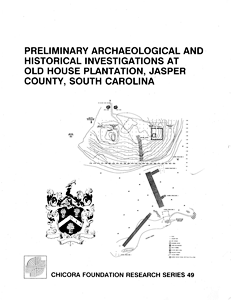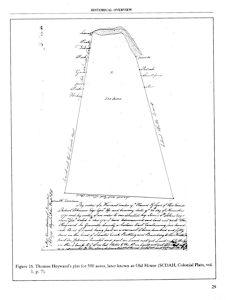In 1980, culminating years of effort by Judge N. Heyward Clarkson, the Heyward Foundation transferred ownership of the Old House property and grave site to Jasper County in hopes that they would improve and maintain the site.
By 1994 when I was elected president of the Heyward Family Association, Jasper County had done little to improve or maintain the Old House site. Several of us on the Association board approached the Jasper County Council and proposed establishing the Thomas Heyward Site Committee to oversee a restoration of the property. In particular that included extensive feeding and pruning of the avenue of oak trees and restoring the cemetary wall and headstones. I served as the Heyward representative on the Committee. After many months, meetings and work, we achieved what we set out to do. (See article, 1994 NL, scroll to p.7)
Simultaneous to this effort, through the auspices of the Heyward Foundation headed by Dick Ellis and the Thomas Heyward Site Committee, Jasper County sponsored an  archaeological and historic study of Old House. We wanted to get National Register of Historic Places designation for the site. This investigation was done by the Chicora Foundation headed by Dr. Michael Trinkley and resulted in a brilliant, comprehensive report titled “Preliminary Archaeological and Historical Investigations at Old House Plantation, Jasper County, South Carolina”.
archaeological and historic study of Old House. We wanted to get National Register of Historic Places designation for the site. This investigation was done by the Chicora Foundation headed by Dr. Michael Trinkley and resulted in a brilliant, comprehensive report titled “Preliminary Archaeological and Historical Investigations at Old House Plantation, Jasper County, South Carolina”.
Recently moving from Colorado back to Savannah, I came across this study and wanted to share some of its findings regarding the history of Old House. We all know of Old House. But exactly what is its history? Who were the primary Heywards who settled, built and lived at Old House? How did Old House become the Heyward family seat? How long were the Heywards there? Dr. Trinkley’s research and compilation of the site’s history provides a fascinating insight into Heyward history from 1766 to 1830.
The study focuses on Daniel Heyward, Thomas Heyward, Jr.’s father. Daniel developed Old House as the family seat in remote Granville County (now Jasper County).
Daniel’s father was Thomas Heyward, born in 1699. Thomas cultivated the family plantation on James Island across the harbour from Charleston. In 1715, at sixteen, Thomas was drafted to fight in the Yemassee War (the last stand of southeastern native Indians ). His mother petitioned for his release from this obligation due to his age. In 1725, at 25 years old, he was appointed Captain of the James Island Militia. On March 16, 1732, the South Carolina Council received a petition from

Thomas for 500 acres in Granville County (Old House property, “an area isolated, still a frontier”).
In the early 1730’s Thomas was expanding his holdings and working his assets buying/selling real estate in Charleston and advertising for runaway slaves. He did this through the South Carolina Gazette.
On January 1, 1733: “a large garden containing two town lots with several fine Orange Trees and sundry other conveniences at the upper end of Broad Street, also, two Milch Cows with calf to be sold (S.C.G, January 1, 1733, p.3). Also: A corner lot in Charlestown, over against Mr. Brandt’s, 100 foot front on Broad Street, and 200 Foot Front on the Street that runs from Ashley River to the Broad Path (S.C.G, April 14, 1733).
He also attended to finding runaway slaves.
On April 1, 1732: “Run away from Thos. Heyward on James Island, the 22d of February last, a Negro Woman named Bess, about 19 years old, pock fretted, a lusty wench, and speaks good English, being born in this Province, she had on when she went away a Gown of white Cotton and a linnen pettycoat: Any person the said Negro to Mr. Ellis, constable in Charleston, or will acquaint me or the said Ellis where she is, so that she may be had again, shall be well rewarded by Thos. Heyward. (S.C.G, April 1, 1732, p.3)
And again in 1735: Run away the 3d of this last, November from Thos. Heyward of James Island, a young negro wench named Amy, this country born, she is very black, and has thick lips and very large breasts, had on an Oznabrig coat and jacket, and an old Negro cloth gown: Any person that will bring her to her to said Master, or to Goal in Charleston, shall have 3# reward by Thos. Heyward. (S.C.G, November 8, 1735, p.3)
On March 11, 1736 Captain Thomas Heyward, age 37, died at his James Island plantation and was buried in the St. Andrews Church graveyard. On March 7, only four days before his death, despite his military career and activities as a planter, in his will, he described himself as a “hatmaker”. This apparently follows family tradition where his grandfather, from Little Easton, England, listed his occupation as “Hatter”.
In his will he provided for his wife Hester, then instructed that the remainder of his estate be divided equally amongst his six minor sons, Daniel, Thomas, John, James, Nathaniel and Samuel. Daniel eventually settled Old House while John developed Tichton Plantation and James settled Sandy Hill. Thomas left Daniel slaves, his watch, sword, pistols, and “my other Accountrements”.
Thomas’ will wasn’t proved until seven years after his death, 1743. That year his son Daniel likely left James Island and set out by water to settle his father’s grant in Granville County (Old House). That same year, Daniel married Mary Miles, daughter of William Miles, a St. Andrews Parish planter. The wedding apparently took place at St. Andrews, with the Reverend Mr. William Guy, rector of the church, officiating. (PAHI, p. 31)
(To be continued)

